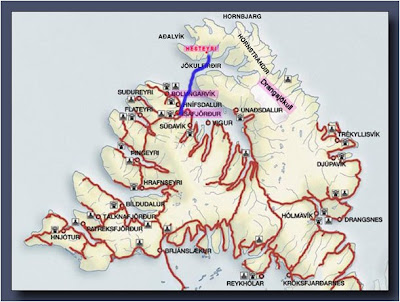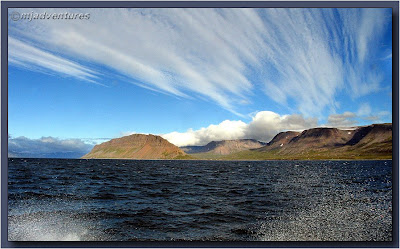Click on the images to enlarge them
Waking the next morning in Bolungarvik, we had to get up and out reasonably early as we had no food in the house for breakfast. We were due to catch the ferry to Hesteyri at 6pm but we had shopping to do for food beforehand, as there aren't any shops in Hesteyri and we were going to be there for 8 days.
J's friend had told us that Bónus was (again) the supermarket at which to shop, so we piled into the car and headed for the only Bónus in the area, in Ísafjörður and located halfway between the main town area and the airport.
 Ísafjörður township from the road to the airport. It's built on a sandspit where the inner Skutulsfjörður fjord meets the waters of the outer main Isafjarðardjúp fjord
Ísafjörður township from the road to the airport. It's built on a sandspit where the inner Skutulsfjörður fjord meets the waters of the outer main Isafjarðardjúp fjordOur hearts sank as we neared the building as there were no cars in the parking area and it looked very quiet. Sure enough, the supermarket was shut and wasn't due to open until mid-day. It was now only 9:30am!
We headed back into town, locating a smaller, (open) supermarket where we bought food for breakfast and lunch, and then headed back to Bolungarvik to pack our stuff and rest up.
I took a little walk around town which wasn't that big. Bolungarvik is surrounded by 4 big mountains - Óshyrna, Ernir, Tunguhorn and Traðarhyrna. Its main industry (and reason for existence) is fishing, although even that has considerably slowed down in recent years.
When I was researching Iceland before our trip, one of the most interesting articles that I found on Bolungarvik was this piece written by Jonas Moody and published in the Autumn 2007 edition of Iceland Review. From personal perspectives of some of the townsfolk, Jonas writes of the dilemmas people are facing as the fishing scales down and the work dries up.
The 2008 census counted a population of 905 in Bolungarvik. The West Fjörds now only account for 2.3% of the total Icelandic population, down from the 14.2% in the 1920s when fishing and whaling were experiencing boom times.
I'll have more images of Bolungarvik in a later post which will describe our day spent in the region on the way back from Hesteyri.
At 3pm, we packed up our stuff and headed back to Ísafjörður. Just as we left Bolungarvik and headed along the coast, we spotted a small family pod of Orca making its way down the fjörd towards the open sea. Although they were too far away to take photographs, we were thrilled to be able to sit and watch these beautiful creatures which we hadn't seen before in the wild. There looked to be one big male with a very tall dorsal fin, and perhaps 2-3 females with a couple of calves.
Yay - Bónus was open! Equipped with a couple of trolleys, we waded our way into the shop and bought enough provisions for 8 days in the wilderness. To store all the food we also had to buy 2 plastic bins with lids which were €20 a pop. We approached the check-out with some trepidation - how much was all of this going to cost? To our surprise, the total was €220, including the €40 for the 2 plastic bins, and we didn't consider that to be too bad for 4 people for 8 days. It was certainly less than we had expected to pay.
We headed for the dock where we were to catch the fast ferryboat to Hesteyri. We were about an hour early, so while J returned the car to the café, I walked around the wharves and took some images.
Just before 6pm and with the help of the crew, we loaded all our gear onto the ferry and off we went - heading at high speed across Ísafjarðardjúp - towards a smaller fjörd called Jökulfirðir (Glacier Fjörd) on the Hornstrandir Peninsular, the most isolated part of Iceland. As you can see on the below map, there are no roads in these parts!
The crossing was invigorating and we were excited to be on this leg of our trip. The boat shot across the calm water and we watched fishing gulls and puffins scatter out of our way as we neared them.
In the far off distance, we saw a whale (most likely a Humpback) surface, and the high mountains of the fjörd were breath-taking - as was the cold wind if we happened to stick our heads over the side of the boat and out of the shelter of the cabin!
We saw some impressive cloud formations as we got closer to the Hornstrandir side.
As we approached Hesteyri, the boat slowed and crawled to the jetty. The tide was out, so not bottoming the boat was a prerogative.
We were met by Hrólfur, the husband of J's friend, who helped us with our gear and showed us the way to the lodge which is run by his mother Birna.
After introducing us to Birna and a couple of other lodge guests, Hrólfur showed us to our upstairs bedroom that was to be our home for the next 7 nights. It had 1 double bed and 2 bunk beds, so we organised who was going to sleep where, spread out our sleeping bags and set some ground rules with the boys about keeping the room tidy!
Going back downstairs, we re-arranged our food boxes. One with non-perishable goods stayed on shelves in the pantry area which also doubled as the entry way where jackets and outdoor shoes resided. It was about 10°C in there during the day, dropping to about 5°C in the later hours - I can't really say night-time as it never got dark!
As there is no power in Hesteyri, there is no refrigeration, so the other box with all the perishable items such as milk, Skyr, fruit, veges and meat went outside - into the stream which runs conveniently beside the house. The cool 2°C water kept everything nicely chilled!
As it was now 8pm, we cooked dinner in the communal kitchen and talked a while with the others before collapsing into bed at 11pm.
Next Chapter: History of Hesteyri















0 comments:
Post a Comment